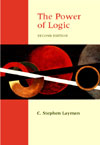|
 |  The Power of Logic, 2/e C. Stephen Layman
Feature SummaryEnduring Features- Each chapter includes numerous exercises designed to show the power of
logic as a tool for (a) formulating issues in a revealing way and (b) evaluating
significant arguments on interesting topics.
- As regards the order of presentation, the early chapters focus on relatively
informal methods. More technical material is introduced gradually, with symbolic
logic receiving thorough treatment in chapters 7, 8, and 9.
- The writing is concise and lively throughout the text. You’ll be the judge
of this, of course, but if The Power of Logic is more readable than
most texts that cover similar topics, then it has at least one important pedagogical
advantage.
- The chapter on truth tables includes a discussion of the material conditional
and its relation to the English if-then, and emphasizes abbreviated truth tables.
- The system of natural deduction for statement logic is entirely standard,
consisting of eight implicational rules, ten equivalence rules, Conditional
Proof, and Reductio ad Absurdum.
- The chapter on induction includes standard material on statistical syllogisms,
induction by enumeration, arguments from authority, Mill’s methods, scientific
reasoning, and arguments from analogy.
- The exercises on arguments from analogy require students to evaluate
a stated criticism of each argument, which makes the exercises relatively easy
to grade.
- The chapter on probability keeps the focus on argument evaluation. The exercises
on Bayes’ Theorem involve a wide variety of applications, including applications
to philosophical issues.
|
|
|



 2002 McGraw-Hill Higher Education
2002 McGraw-Hill Higher Education

 2002 McGraw-Hill Higher Education
2002 McGraw-Hill Higher Education